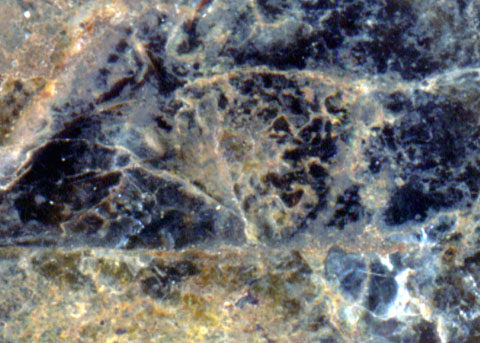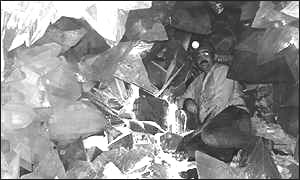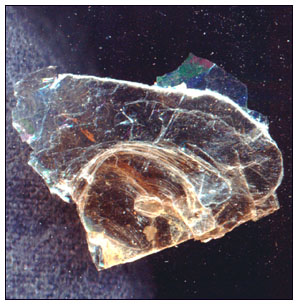The Book of Mica
Before the birth of Loon Island, of Lake Bonaparte, or of the Bonaparte hills (which are only the stumps of mountains older than the Hymalayas) all this area was under an annonymous sea.
That sea had a long sedimentary existence during which many bezillions of oysters, clams, and conks lay down their shells to form deep beds of limestone
Then one of earth's larger cogs clicked one notch, and as it did, the crust of the planet cracked open. Up welled and out flowed the hot magma.
The forward lobe of the advancing magma met the old sea and virtually vaporized it, leaving the shrunken puddles of itself which we call the Great Lakes, and a wide band of mineral deposits and cystalizations along the lines of the violent confrontation.
In our North West shield country, the most spectacular example of the mineral formations resulting from the great Cambrian Event was the formerly famous Crystal Cave between Lake Bonaparte and Natural Bridge. A giant geode with crystals pointing inward, the Crystal Cave formation was sealed at creation and unknown to anyone until modern mining machinery accidentally exposed it in the early twentieth century. The crystals were so large and spectacular in their array, that the cave was dismantled and removed by the state geologists. Some years later the crystals were remounted in a similated cave at the state museum in Albany, where it became a major draw, and had itrs brief fame.
But after the dust had settled for a few years, the cave was dismantled for cleaning. Now, thirty or fourty years later, the Crystal Cave is stacked and stored in the state museum, like, as you might say, a trout stream in a junkyard, well forgotten, even on its native ground.
The Cave, restored to this area, would be usefull as a tourist attraction for its huge curiosity, but the smaller quartz crystals available to early prospectors who poked around lake shores and open seams , would have been usefull as actual weapon points, and others would have been adopted for optical or magical purposes.
Most minerals occuring as ore would have been of no interest to primitive gatherers, but iron ore, which is still being mined in this corner of the Adirondacks is the source for Indian ochre pigment, just as it was, mixed with milk, for use by the white farmsteaders as barn paint.
And there is lead in these hills. Individual Indians were observed into the late nineteenth century packing out lead from their own secret lead source somewhere here abouts. Maybe some of the the stone agers were handy with lead, as it could can be smelted at low temperatures and hammered cold to make net weights. Late ninetheenth century Indians observed on their way to and from the lead deposits probably used the lead primarily to cast bullets.
I recall looking out our window in Natural Bridge and seeing a man on his way home: his face , clothes, and lunch box(and maybe the inside of his lungs) all powdered white from the talc of the Natural Bridge mine. Some of the bare-ground Indians would have come to grind a pouch of the local talc maybe to be addwed to bear grease as ghost face pigment .
But the most visible and possibly the most alluring of the shield shore minerals would have been the the mica which is a morphologicaol cousin of talc and crops out in the Bonaparte hills in jumbled shelves of chunky books, each of which books even a small boy can open; and the resulting sections can be opened to many translucent volumes, every one of which can be opened to more and more transparent pages.... until the books are read away to nothing by fascinated children. Or so it happens on Loon Island.
Mica is actually useful as a fire proof sort of proto glass, and though there were probably very few long houses with mica windows, the early native gathers would have found mica useful as an accent in decorative quill and bead work.
In the late eighteen hundreds the Bonaparte Mica outcrops were exploited by white prospectors, probably using mules to pack out the largest specimins to be used for stove and lantern windows.
Following that short episode, the tailings and crevases were scavanged by our grandparents and our parents, then picked over by us as kids, and now are all but lost to the hundred year jungle.
One of the old lake postcards sold at Priests Bonaparte store was a simple outline of the lake showing the main islands, Bonaparte Cave, a few neighboring ponds, and not just one but two x's indicating mica mines down at the West end of the lake. My family only knew about the one mine.
When I was twelve and my brother Herb was sixteen we took the post card as a guide and went looking for the lost mine.
We soon lost ourselves and we stayed lost for half a day, during which we found Indian Lake, Burnt Pond twice, and one or two other things I might tell you about..... but didhn't fnd the mine. Never did. Today, I probably couldn't even find the one we used to visit.
But up on the Loon Island fireplace mantle, at the base of the stuffed owl along with the autobgraphed artist's fungus, and the iron- slag turquois from Alpina, we still have at least one unopened book of mica.
And it is the mica in the granite and shist which, on a good day, makes the Loon Island shore line sparkle like a bracelet.
Foot Notes:
Lake Bonaparte has its basin in the granite and shist of the flowed shield and its primary feeder springs in the limestone of the old sea bed, reversing the usual direction of flow down off the granite shield to the limestone plain. The result is a clear, sweet, and fertile lake, which will percipitate a thin bed of calcite when it suddenly boils away.
There is a story that George Washington worms, vary large man in all tellings, sometimes said to be part Indian or gypsy, made for himself a pair of lead shoes, so that he could stand in the deep fast water and snatch fish which were trying to jump the falls. He didn't wear the lead shoes outside of the water, but he often waded in to just be with the fishes, and it may be lead poisoning which killed him, in his mid thirties.
Irv Priest, the long ago Uncle Sam look alike, historian, and entrepeneur of the Lake Bonaparte South Shore used to publish and print, not only post cards, but also several booklets of lake Bonaparte and local area history. He is the source for for much of my information on on these subjects, is still richer and more relaiable than the internet, and himself a subject worthy of a book.





